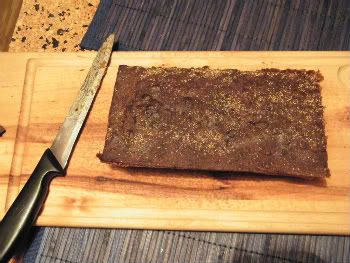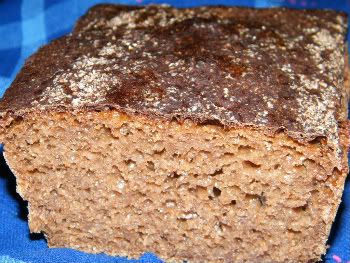Leivategu
>> Monday, November 16, 2009
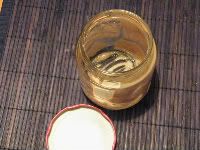
Last Wednesday I decided to give it a try at rye-bread-making. I gathered all the ingredients on Thursday from Selver. I was happy to find everything I needed - rye-flour, malt-extract, kvass-extract and rye-bran. I had the fortune of having the juuretis (starter made with water and flour left to ferment for a day) at home since my aunt has spent a year now baking her own bread.
The process started on Friday with mixing half of the 1,5 kg Veski-Mati rukkijahu into the bowl with 1,5 L of water. Then in went the starter. As you can see I didn't wash the jar and just left it empty in the fridge. Mixing took a while, I ended up with this bubbly mass.
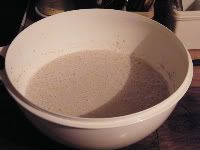 I covered the bowl with a lid, wrapped it all in a thick towel and left it to ferment over night right beside the heater. The longer you ferment it, the more sour bread gets. Next morning I was greeted by a very lively and smelly mass of dough. I mixed in 3 tbsp of grounded sea-salt and 1,5 dl of sugar and scooped out some of dough to fill the empty jar for juuretis.
I covered the bowl with a lid, wrapped it all in a thick towel and left it to ferment over night right beside the heater. The longer you ferment it, the more sour bread gets. Next morning I was greeted by a very lively and smelly mass of dough. I mixed in 3 tbsp of grounded sea-salt and 1,5 dl of sugar and scooped out some of dough to fill the empty jar for juuretis.
As for now, this starter is very lively and has filled the entire jar, despite only filling less than half of it. This means that I can bake some more bread in the future. Possibly in the near future as they say - once you get into it, then it's very hard to go back to eating shop-bought bread.
Next went in rest of the flour and 1,5 dl of malt-extract or maltoosa. That is usually used to make beer. It gives bread unique smell and taste, but it is a pain to measure it as it is gooey and sticks everywhere. After malt I added some kvass-extract (two satchets) for more intense colour, rather than flavour.
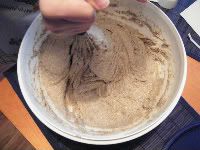
I also added some (3 dl) of rye-bran for more fiber. After mixing it all well I poured a small part of the dough in a separate bowl and added some pumpkin seeds. Of course, any kind of seeds could be added but I'm not a huge fan of seeds in particular. Also, you can add raisins or dried fruit to make sweeter bread. I have my eye on a recipe for sweet Christmas bread by Maru (she has got to be one of the most important inspirations for me in the kitchen). This time I opted for saltier bread, for sandwiches and alike.
Next step in the process was to grease the tins with butter. I could only find two decent baking tins. Decent means that they are made of quite thin layer of metal, otherwise the sides and bottom will not turn out as crunchy as the top. The third tin I found is usually used for making star-shaped sponge-cakes for birthdays. I thought that it would be fun to have a star-shaped seed-bread, so the seedy dough ended up in there. I left the dough to ferment and rise in the tins under a warm blanket of a towel for an additional 5 hours. This process could be done the night before - so all that is left to do in the morning is to elegantly throw the tins in the oven and enjoy breakfast with some warm bread.
I pre-heated the oven to 250 C and managed to fit all of the three tins on the same rack. It's essential that all the tins get same amount of heat. I left the high temperature on for 15 minutes to form a nice crunchy crust and then switched it to 200 C and baked for another 40 minutes. It is very important not to open the oven's door for the entire process or otherwise you will end up with very cracked bread. For the last five minutes I turned the heat off and let the bread set.
And out came the bread. I can't describe the lovely smell of rye that arose from those three tins. I immediately caressed the breads with some cold water on my hands so that the crust wouldn't be too hard. They were very hot so some caution was required on my behalf. Water evaporated almost as soon as it touched the surface of the bread. After that I removed them from tins and wrapped them in kitchen towels. I ended up with three warm babies on the table. The minimum amount of time we all could bare to let them cool was 30 minutes. Then I cut the first slice of my very own home-made rye-bread and it was gorgeous.
It was exactly how I remembered the bread to be when it wasn't sold sliced in plastic bags but in tall boxes in the corner of the shop. The texture was chewy but that's due to the freshness - this bread is meant to last for two weeks. Yeast based rye-bread is easier and faster to make but doesn't have the unique taste and won't stay fresh for long.
I will be definitely making more of this soon.

